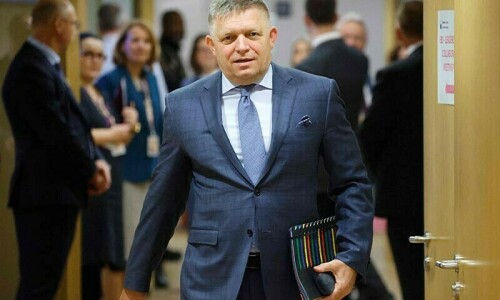KARACHI: The historical lakes of Sindh, which have also been declared wildlife sanctuaries, are shrinking due to a host of reasons including reduced supply of water and encroachment, it emerged on Sunday.
“Insufficient water supply and encroachment are making the situation worse at the lakes,” according to official documents reviewed by Dawn.
A report recently prepared by the Sindh wildlife department said the water supply to Haleji Lake in Thatta was inadequate. It explained that the lake’s required water level was 28RL (reduced level) but it was currently at 17RL. The reduced water supply to the wildlife sanctuary was partly the outcome of the government decision in 1994 to stop supply of water to the Haleji Lake from the Keenjhar Lake, it added.
Once an important wetland spread over 17 square kilometres on the Eurasian continent, Haleji Lake was also known as Birds’ Paradise. Even at present it provided a natural habitat to more than 20,000 birds of different species. They included pelican, coot, moorhen, spotted eagle, mallard, grebe, cormorant, heron, egret, spoonbill, flamingo, pintail, wigeon, shoveller and gadwall. The lake was designated as Ramsar site in 1976 and wildlife sanctuary in 1977.
The same level of deterioration has also been noticed at Drigh Lake in Kamber/Shahdadkot district. Declared wildlife sanctuary in 1972, Drigh Lake lies in a shallow depression covering an area of 1.64 sq-km, where a population of 20,000 birds has been recorded.
The official report revealed that this lake faced the challenge of encroachment.
Similar situation has been recorded at Lungh Lake in Qamber-Shahdadkot district. Spread over an area of 0.40 square kilometre, the lake was declared a wildlife sanctuary. It was considered the best lake across the Upper Sindh for it provided ideal habitat to waterfowl. The present population is estimated to be more than 30,000 birds. The habitat comprises three types namely open water with typha and juncus on edges, swamp area dominated by tamarix and surrounding rice field dominated by juncus.
Another wildlife sanctuary in Shaheed Benazirabad district, Deh Akro-II, has been facing a grim situation since the discontinuation of water supply to it from a canal.
The Deh Akro-II wildlife sanctuary is considered a combination of lakes and sand dunes. Declared wildlife sanctuary in 1988, it is spread over an area of 202 square kilometres with ‘picturesque piece of land and amazing topography with small and large lakes with intervening sand dunes’, according to the report.
More than 20,000 birds regularly congregate at the sanctuary besides there were crocodiles, monitor lizard, marbled teal, partridge, houbara bustard and waterfowl such as mallard, pintail, egret and heron etc.
At least there were 29 lakes in Deh Akro with intervening sand dunes, said the report.
Published in Dawn, June 29th, 2015
On a mobile phone? Get the Dawn Mobile App: Apple Store | Google Play















































